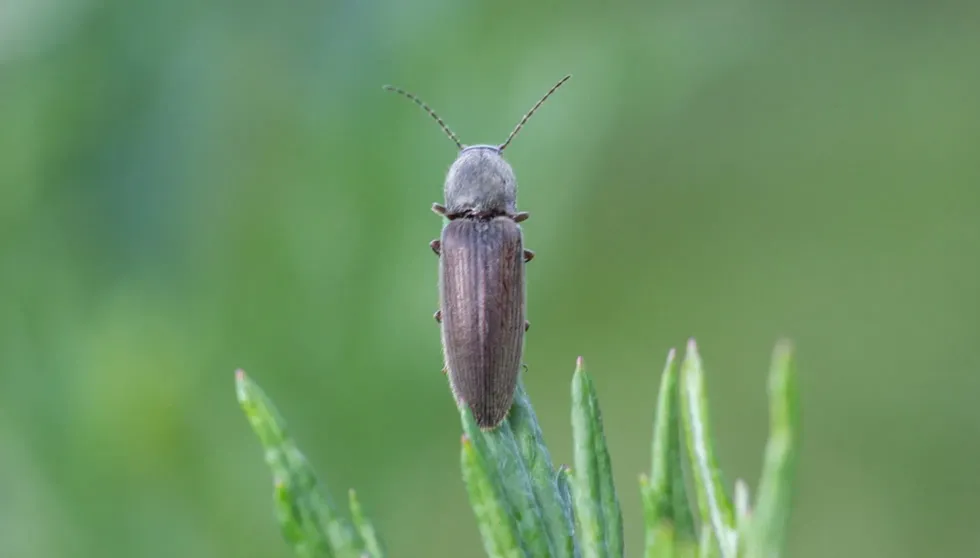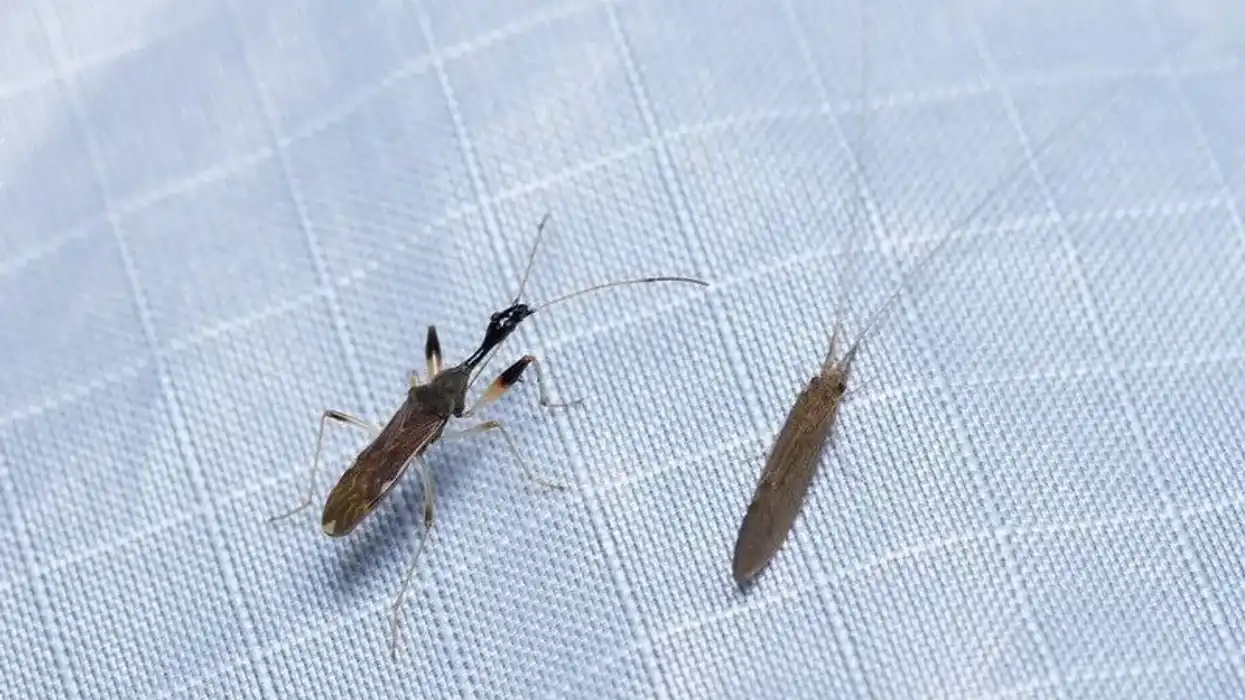Click Beetle larvae are insects that come from the family Elateridae and are usually called wireworms. These small insects eat dead plants, some live in agriculture and they're often referred to as agricultural pests.
The adults prey on other insects known as Aphids.
The long list of species of Click Beetle includes 9000 species, which are often seen living on soil, around roots and branches of trees. These Click Beetle or wireworms are named for making a particular characteristic clicking noise when they are attacked and squeezed by predators.
Although Click Beetles are usually are not harmful to humans they're a serious pest to agriculture and can result in big losses.
These Elateridae upon a touch play dead by falling on their back. Click Beetle bends its head and thorax forward and when in a safe environment where they fear no predators they right themselves and hurl themselves into the air.
Some of the famous species of these Elateridae are Glowing Click Beetle, Eastern eyed Click Beetle, Violet Click Beetle, Pyrophorus nyctophanus, Pyrophorus noctilius, and many more. The most common adult Click Beetles are black and brown with little or no ornamentation on their back.
These wireworms usually live off soil, plants, or as a pest on agricultural produce.
If you want to know more about these animals, we have collected all the Click Beetle facts for kids, their behavior, and their lifestyle! For more similar content, check out western conifer seed bug and mud dauber wasp facts.
Click Beetle Interesting Facts
What type of animal is a Click Beetle?
As the name suggests, Click Beetles is a beetle that falls under the category of insects.
What class of animal does a Click Beetle belong to?
Species of the Click Beetles larvae belong to the family of Insecta.
How many Click Beetles are there in the world?
Click Beetles larvae are widely studied and there are 9300 known species of Click Beetles out of which there 975 species just in North America.
Where does a Click Beetle live?
Species of the Click Beetle larvae are most found under bark, in a block of decaying wood, or on plants or soil.
What is a Click Beetle's habitat?
Generally, the Click Beetle larvae love to habituate under the bark of a tree, in decaying wood, on plants, and on farms.
They love to hide under the bark of a tree and can reside there as long as they want, and according to the studies, it appears that they love to breed in decaying woods or snapping in the air from one crop to another. They're very rare in deserts or flooded areas.
Though these wireworms are seen feeding on crops and farmers often set sweet traps during springtime to trap the adult beetles.
Who do Click Beetles live with?
Mostly, Click Beetles larvae reside under a decaying bark or around the roots. They can move from one plant to another loving their own solitary company, but some may prefer to inhabit in groups.
How long does a Click Beetle live?
Some species of Click Beetle larvae live for two to three years provided they're in cold weather. Else they complete two to three generations in a year. Being nocturnal (active during the night) they're more often seen in the nighttime snapping from one plant to another plant clicking their way through.
How do they reproduce?
The mating season for Click Beetles is generally in summers, where they have their complete metamorphosis. The female adult Click Beetles lay eggs ranging from 10-100 on the soil where they have four stages of development - egg, larva, pupa, and adult Click Beetles. After mating, the female lays eggs and they hatch within 7-35 days.
What is their conservation status?
The conservation status of these pests is of Least Concern as per the IUCN. This is because Click Beetles are commonly found in their habitat and they have a wide number of species which rounds about 9000 out of which 900 are found alone in North America.
Though. the Violet Click Beetles are endangered because of the habilitation problems they face.
Still, the species of Click Beetles are widely found in North America as well as Australia. Being nocturnal creatures they feed on leaves in the night and as they're attracted to sweet liquids farmers place traps in the springtime to trap the adult beetles.
Click Beetle Fun Facts
What do Click Beetles look like?
A click beetle mostly has a rough body surface and is of black and brown color with little or no ornamentation. Its body is elongated compared to its head.
How cute are they?
The basic appearance of the Click Beetle might scare off humans but the fact that they play dead if they fear predators makes them cute.
How do they communicate?
Studies show that Click Beetle larvae communicate by relying on their senses of touch and smell to communicate with each other.
How big is a Click Beetle?
Adult Click Beetles have a total length of less than 0.75 in or 2.5-18 mm. Most Beetles are of the same size.
How fast can Click Beetles move?
The larvae and adults move quite fast once they see any sort of light. They do run fast but the exact speed is unknown.
How much does a Click Beetle weigh?
The weight of adults varies but is around 0.8 oz or 18-22.7 g. This is quite light when it is compared to cockroaches which are almost of the same size.
What are their male and female names of the species?
When it comes to insects there is no specified demarcation among male and female Click Beetles.
What would you call a baby Click Beetle?
A baby beetle is known as a larva or a baby wireworm.
What do they eat?
Generally, larvae live on leaves, nectar, pollen, flowers whereas adults prey on soft-bodied insects known as Aphids.
Are they harmful?
No, they're not at all harmful to humans if found inside a household but they're a serious pest for crops.
Would they make a good pet?
It wouldn't be healthy for beetles to live as domestic beings as they are not able to survive inside a household.
Did you know...
These larvae have three pair of legs along with two pairs of wings with a rectangular body which is elongated in size.
They are a serious threat to crop and they attack the seeds, plant roots, and their natural enemies are birds, bats, frogs, and lizards.
Click Beetles can jump into the air to a height of 30 cm.
Behavior of the Click Beetle
If they sense any threat or if touched they'll fall on their back playing dead in order to survive the predators, and once they feel that the threat is no longer there, they hurl right into the air.
They correct themselves by bending their head and move forward by hooking a spine onto the thorax and then into a notch on the abdomen.
Aside from this, these beetles also pests and pose a serious threat to crops.
Why are they called Click Beetles?
Click Beetles are named because of the clicking sound they make when squeezed by predators or launching itself into the air after playing dead.
Here at Kidadl, we have carefully created lots of interesting family-friendly animal facts for everyone to discover! Learn more about some other arthropods including giant African millipede, or atlas beetle.
You can even occupy yourself at home by drawing one on our click beetle coloring pages.










